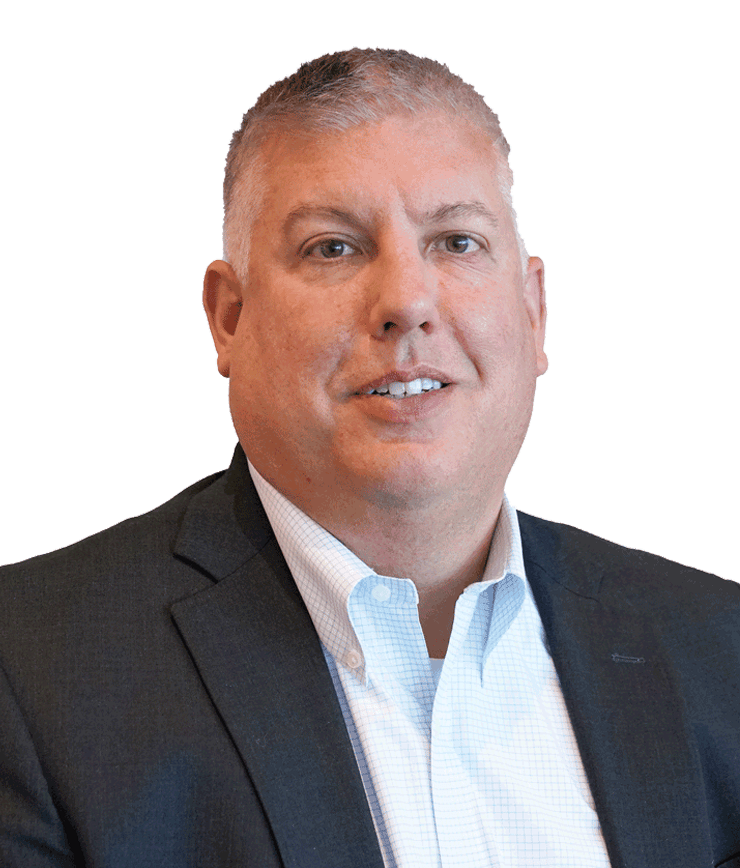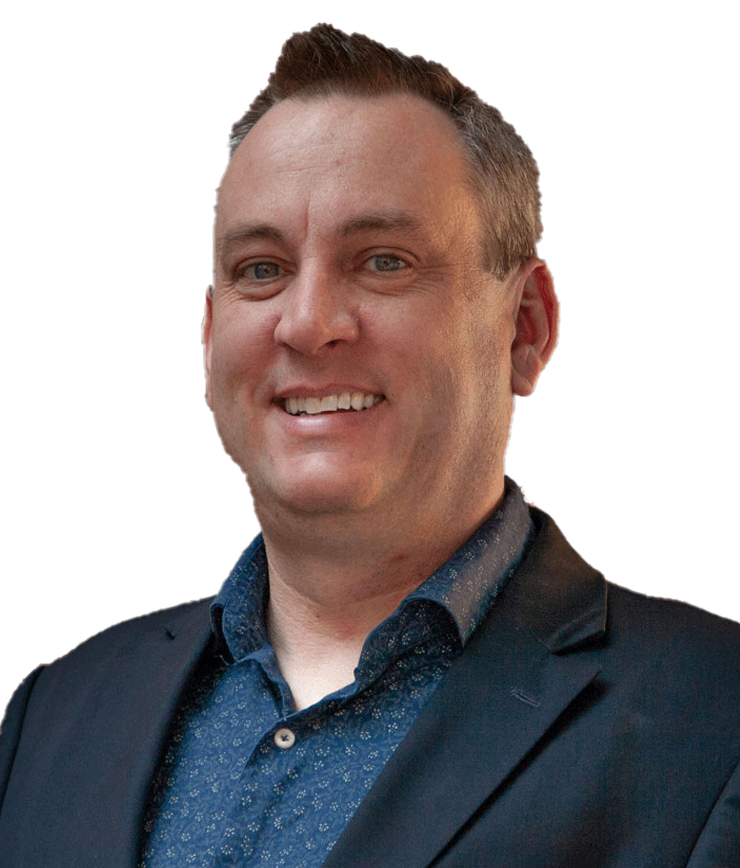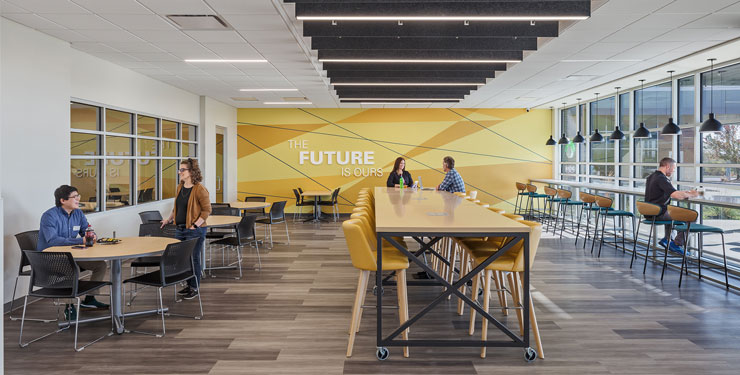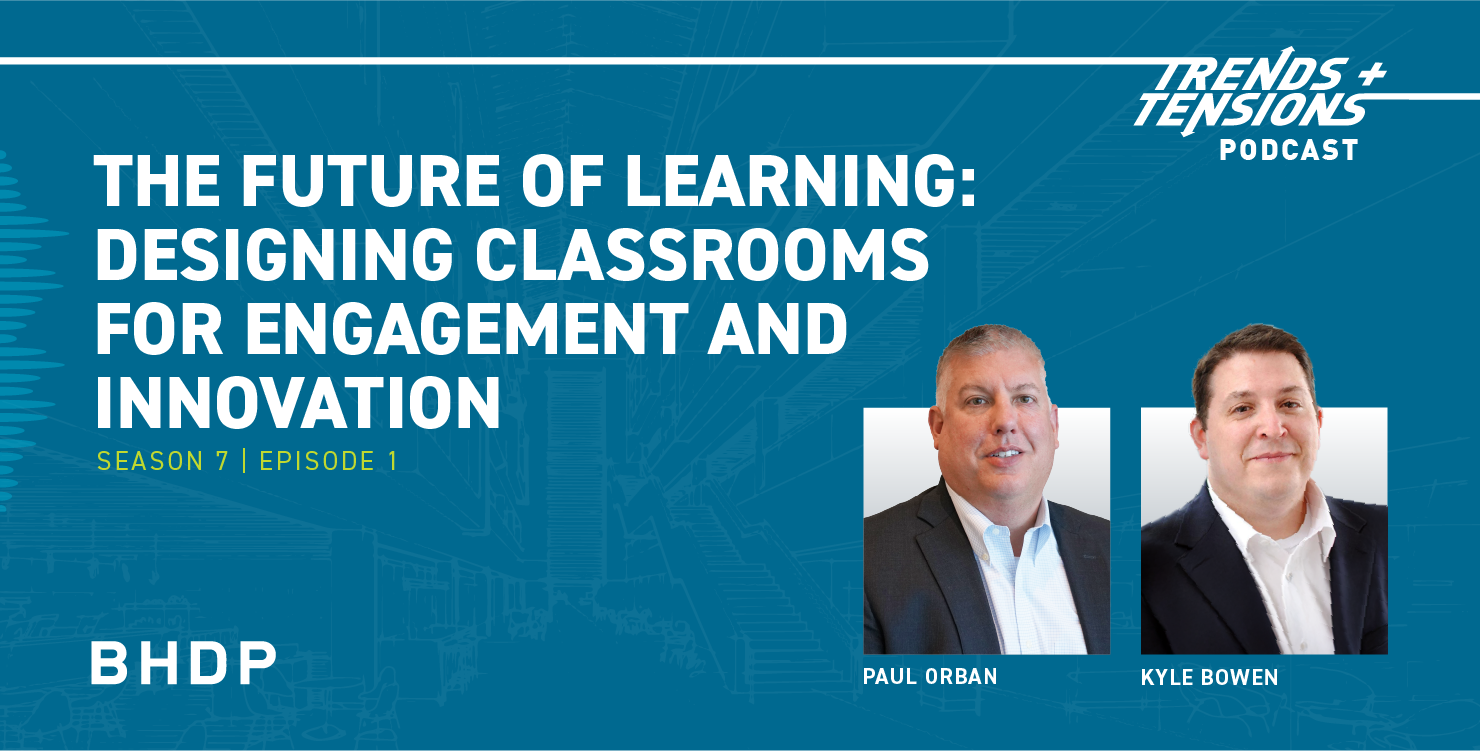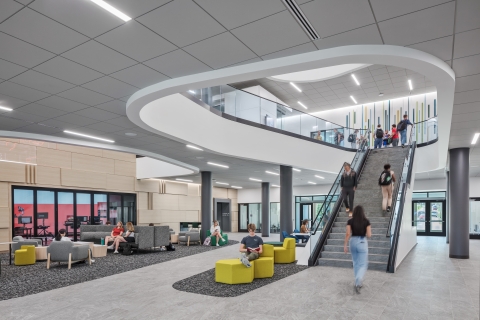
CFOs and Campus Futures: Innovating Financial Strategy in Higher Education

Want to listen on another platform? Choose your platform here.
Episode Transcript
[Music Intro]
Brian Trainer, Host: Welcome to Trends + Tensions in Architecture and Design, presented by BHDP, where we discuss trends in architectural and interior design and the competing priorities or tensions that arise from integrating new ideas into existing organizations, enterprises, and institutions. In this episode, “CFOs and Campus Futures Innovating Financial Strategy in Higher Education,” we are joined by Allan Mark, CFO of Belmont Abbey College, and Paul Orban, Managing Partner at BHDP. I am your host, Brian Trainer, Senior Strategist for BHDP. Let's get started.
Allan, if you wouldn't mind, tell us who you are and what you do.
Allan Mark: Thanks for having me, Brian, and Paul. I am Allan Mark, the Chief Financial Officer at Belmont Abbey College, starting my 18th year in higher education. I've been in higher ed for quite some time. Before higher ed, I was actually a certified public accountant. I started my career actually as a teacher. I was in the classroom, so I've always had a deep connection to education. I really enjoyed the administrative side, the finance and operational side of it, and I'm happy to be here and contribute to and add to the content.
Brian: Thank you, Allan. And then, Paul, remind people who you are and what you do.
Paul Orban: I'm Paul Orban. I lead the higher education market for BHDP. I've been doing this for almost 20 years and have spent a deep part of my career in higher education, especially independent colleges and universities like Belmont Abbey.
Brian: Thank you, Paul. We're talking about you as a CFO, the chief financial officer role, the campus future, and how those are related. Allan, what role does the CFO play in strategic campus planning?
Allan: There are layers. Your first layer is always this kind of risk management approach, and you're really trying to see the landscape and navigate financially with a lot of moving variables. So that's a standard. And then you get into this layer of strategic visioning and strategic partnerships with your key constituents, the president, colleagues in the cabinet, and board members.
Paul: Yeah. Allan, I think that's a great point. We've done a lot of campus planning and architecture, and I would say the most successful campus planning engagements and strategy engagements we've been involved in, the CFO has played a very important role at the table in bringing that business analyst view to strategies and decisions. The reality is that everything has a financial implication, whether it's a good one or a negative one, right? However, these decisions that are being made in terms of the future of campus facilities and investments all need to have that business element of how it will ultimately impact things like enrollment and hopefully the institution's bottom line. How's it gonna affect debt? All those important things, revenue. And with the CFOs engaged in that process with us and really bringing that information and insight to the team, that's where we see these very strong implementable plans that we will actually move the needle for an institution.
Allan: Yeah. That's a great comment, Paul. I can't imagine a process that doesn't have the CFO at the core of that planning for the campus facility. Generally, the overseeseing and is responsible for the physical plan. If you look at budgets purely from a budget perspective, running the facility is generally one of your most expensive line items. If you roll everything else up, I wanna say it's as high as 20%, and most, I think, are in the 12% to 13% range of their operating budget. So, it's a pretty significant dollar amount.
Paul: I agree that when the CFO is responsible for facilities, that brings that executive leadership level of information decision-making to the conversation. Usually, where things sometimes go wrong is when the CFO—maybe they're overall in charge of facilities—is not engaged and has delegated that maybe to a facilities director. No disrespect to those positions, but they don't usually have that direct pipeline to the rest of the cabinet.
Allan: You're so right. That’s a great point, Paul. I've had the luxury of having two really great facilities directors. And I do delegate quite a bit to them, but there's always finding that balance of delegation from the day-to-day perspective and then the bigger picture plans. It's very delicate. I'll say that I could not do the job effectively without a really strong and effective director of facilities.
Paul: They have that daily pulse on the campus, right? How things are operating, what's working, what's broken?
Brian: What's the CFO's role in driving innovation within the higher education infrastructure?
Allan: That's a great question, Brian. Driving innovation is half psychological. Because I think your team is really trying to create an environment where none of us can do it by ourselves. I can't sit there with a president or another cabinet member and say, Hey, we're gonna innovate. Let's move and run. We'll drag everybody with it. So I think it's more leaders on campus who are in those specific areas, like facilities, who are very budget-conscious and great at it. They're wonderful at it. To innovate, sometimes you might have somebody who says, “How in the world, Allan, are we going to do this? I've got a budget for this. This cannot happen.” So, it's a psychological breaking of that barrier a lot. And it's leadership. I think you've gotta have a vision and a will sometimes. And it's, sometimes it's brute force. Sometimes it's, we are going in this direction, we're gonna figure out how we're gonna get there. I'm not saying we're throwing caution to the wind, but let's get in the water and take a swing at moving in that direction. See what happens, and then you'll be confident about your goals and your objectives. You'll ultimately have a team that will look at you and say, “Yeah, I believe in this. We can.”
Brian: Yeah. Innovation and risk are going hand in hand sometimes, so it's like, what's your risk appetite? If it's zero, then that's your innovation level. What are some key challenges and trends in higher education campus facilities today, and how are you addressing those as a CFO?
Allan: The challenge is that I think about it this way sometimes... My son is about to turn 17 years old. He's a junior in high school. He was born in 2008, which means the senior class is coming in 2007. So for the first time, I have a really good grip on the student experience and how he has lived, what he's gonna be expecting to have when he goes to university. I think the biggest challenge remains. You look at facilities that are just aged, they're dated. We're trying to do what we can to find investment to put into the buildings to make the experience what these, born in 2007, 2008, come to expect; that's been a challenge for quite some time in higher ed. As you look across, and I look at this from the living experience on campus, the dorm space, one particular colleague I'm helping and advising right now, their most recent dorm was built in 1998. I would venture to say 50% of the small privates are in that same boat right now, and their living space is becoming a competitive disadvantage.
I know plenty of stories and see the number of students transferring to other schools because of their facilities, which is interesting. I've started to look at retention by facility, which is interesting. I think there can be a lot of other noise and things impacting that, but it's clear to me that we have students in newer facilities that are more modern, their experience is better, and they retain at the school better. And I think that challenge kind of bleeds into the educational space, too. You look at some of the labs that students are coming for, some of the health sciences or other technology-related science areas, and some of the labs are just not what they're experiencing, what they experience in high school. So I think it's almost an arms race in a way, like with some schools, that there's got to be real strategic thought in how you invest in some of these spaces that really flourish.
Paul: I think athletics is the other place that, right now, it is, you said, an arms race. And, you have a lot of schools that are competing for student-athletes. It's been a prime driver of enrollment right over the last several years. Facilities are a big piece of that. When you go to one school, they have an indoor practice facility and a basketball gym with new locker rooms, and you go to another facility, which feels like a high school. That's a big deal. Huge deal. The ripple effect that we're seeing is now just student health and wellness. We know that the incoming generations focus more on their general health, wellness, and well-being. And they're finding that they often can't access those facilities on campus because they are occupied most of the time by the sports teams, the athletics teams, because there's been so much growth, and those poor students are in there from five in the morning until midnight, just to get court time or gym time. And that's another trend, I think, that we're seeing out there: growth in athletics, wellness, and recreation.
Brian: When you're talking about modernizing facilities or being able to adapt to, if there's some sort of changing need in the ecosystem, how do CFOs balance those financial constraints, but opposed to that need for the long-term campus development and upgrade?
Allan: I think of it as the short, the mid, and the long term. And really, you should have an eye on all three at the same time and not be intimidated by the tyranny of the urgent CFOs. They tend to be more alarmed by the tyranny of the urgent, the short term, but you should maintain an eye on all of those pieces. Having a five-year plan and a 10-year plan is something that I would encourage. Deferred maintenance has been a big topic for me recently. Also, we're working through my facilities team to update it and recast it right now. Okay, here's what the needs are, and here's what we can allocate. Obviously, it's never enough. But knowing that, here's what we see as the needs. We're going to plan on this. We've got 10 years. We looked out 10 years ago and saw how much we needed to allocate to each one of these pieces. And then you got the big hitting item, the big hitting roofs, the big hitting boilers. Those pieces have gotta be looked at by themselves, and whether you can create a reserve fund. Or not just having this, the vision to see that, having a long-term goal to create a $150 million endowment, going through a pretty significant capital campaign, and organizing to reach those goals.
I may not be here to see it, but we're putting things in place to ensure the institution's financial stability and ability to operate into perpetuity. So I think it's just a little bit of keeping an eye on all of it at the same time. Each segment is short, mid, and long. It has its own strategies, challenges, and conversations that need to be had.
Paul: Allan, I like the balance approach there because, unfortunately, we see many clients who only focus on that deferred maintenance state. We can't do anything else. We have too many deferred maintenance needs. That stuff's important, and students are going to be unhappy when the heat goes out or the roof is leaking. But at the same time, unfortunately, that's not the stuff. If you invest in it, it's going to bring new people to campus. It's not going to feed that enrollment pipeline as much as some of the other strategic investments. So, it's this, how do you find that balance?
Allan: And there's a dynamic also, Paul, that I think the CFO has to navigate. Let's use deferred maintenance, for instance, we know we have deferred maintenance. We know it's very hard to manage. We're squeezing every month, looking at how to fund certain things. But then on the side, you have an initiative to try to raise money for Project X. So suddenly, money comes in for Project X, and you're building this new facility. I'm in this same situation right now, where great, this new facility is coming online. But then the internal constituencies are like, “Why are we doing this? We need this”. So, a lot of times, it's communication that can impact morale at the institution. So, I think it's really about being able to communicate the dynamic of higher education.
Paul: From balancing the financial constraints. What's your position or thoughts around reducing square footage on campus? Many campuses have grown a lot. We know that everyone has buildings of a certain age. At some point, buildings become more of an issue, maybe of maintenance and deferred maintenance, and they may bring value, or the cost to invest is greater. How do you approach something like that?
Allan: That's a great question, Paul. That's a trend we're seeing, especially in higher ed. Campuses that have some age on 'em, over 75 years old. Some of these buildings and the spaces are just not built efficiently, and this is dependent on the geographical location. What I love is the idea now in higher ed, there's a lot of opportunity here for this very approach or strategy, but partnering with the community, partnering with the for-profit world industry, partnering with industries that are growing, that are looking for a workforce. They would make investments, take a building or a facility, turn it into something of value for them, and bring their operation to your campus. There's a lot of underutilized space in higher ed. I've not gone through that, Paul, but a lot of colleagues I've talked to, we brainstorm about these things, and here's how you can do it.
And so, it's definitely a strategy there. If there's space that's just not being utilized well, it can be used as joint space. I use engineering as an example all the time. Imagine recruiting an engineering company if you want to launch an engineering program. Boy, it would be great if you had a building, a nationally known brand came in, and you could have a headquarters at your campus and create space for a program. Oh, by the way, you've got expertise, an advisory council, and everything right there to launch a program that you know, you may find that the investment is a fraction of what it would cost if you were to try to launch from the ground up. I think there's a big market for that, Paul, especially if your lens on your facility is through student outcomes and success, particularly in your programs. We want to look at our programs, what they are, and what we offer now. Where do we want to be? Let's make the facility match that, not try to force the experience into your existing facility. So yeah, I'm a huge believer in that. Paul, that's a great strategy that I see some colleges taking right now.
Brian: What campus facility investments are having a positive impact on enrollment and student retention?
Allan: I see it in the student housing, just by experience of going through, we put up three new dorms, one in 2021 and two more in 2023. I've seen that as the biggest impact, having the space that the students want to live in. They're gonna be in class X number of hours a day. They're gonna live in these spaces for more hours. So, I've seen that being the most positive impact on retention here.
Brian: What's the difference between housing in the '95s and the modern era? Is it because there's electricity, Wi-Fi, and HVAC? What improvements are having an impact?
Allan: I think it's the technology in the spaces and the comfort of the space. We've got the 1990. I'm gonna get a little bit technical here. These little window split units are what you see in hotels, versus the rooms, now that each room has its own thermostat. HVAC is built into the room. There are returns. It runs efficiently and smoothly. You don't have mold problems if you don't turn the AC on. I think it's just that comfort level and the technology of the new facilities, and not to mention the security, we have suites. Each suite has its own entryway. Somebody can be on campus and just walk into your suite's front door. So, I think that the design and thinking that went into our most recent projects created this pod concept, where on each floor, you have a pod of 16 students in a variety of doubles and singles, but that pod has its own kind of kitchen area. They got it like a lounge area where there's a big TV that serves as a place where they can congregate, but then there's another pod next to them, so that pod connects to one big pod. Whereas the traditional style, the other buildings are really isolated. You've got suites of eight people, just segmenting it around. So it's the design and the creation of community by intention to create that space. So I think the comfort level, just the thought that goes into the designers, guys like Paul's experience in this space, knowing what works and what doesn't work, and seeing what students really want.
If you can create a community and students who make connections with their classmates, they're more likely to stay. The programs are great. The biology or engineering program is a great retainer. But ultimately, it's the students, their experience with their colleagues, and their friends that they're making. And if you create space for that, that's the biggest return you can have.
Paul: It's the more modern amenity spaces we see. Is there a workout facility in the building? What's the study lounge like? It's, as you said, where they connect. With their peers, and it's the different living arrangements. Do I have a variety of choices now versus the old double-edged corridor singles with community restrooms that work for some, but do we have the suites? Do we have the little apartment models? Do we have the town homes? Do we have those different living arrangements for variety?
Brian: Looking down the road, what do you see as priority investments for the future of campus development, and what should campuses look like in the next 10 to 20 years?
Allan: I keep coming back to the living space. You wanna feel good when you come to campus, and really, technology, you're gonna see more and more technology in, particularly in the academic spaces, security technology in the living spaces. The schools in 10 to 20 years will be very successful. We'll have infused that beauty on the outside technology, rich on the inside.
Paul: At a high level, it comes down to how our institution or that campus is unique? Like, how is it memorable? How is it unique? Differentiating from peers because there are a lot of choices, and we know that the potential student population has been trending down, which becomes a supply and demand issue. So it's gonna come down to how you differentiate your campus and what those memorable things are, like Allan just rattled off that. Or that hook for prospective students and current students. And I think every institution has to look at that and really understand who they are as a culture and institution. Then, figure out how that gets integrated into every plan, whether it's a strategic plan, campus master plan, or the design of their next space.
Allan: One thing that just jumped out at me was the fact that we can talk about the demographic changes. We can talk about how higher ed may turn into a commodity from some perspectives, and it doesn't matter where you go. Can we go online? I think there's always going to be a space where students want to come and have a physical presence. They want to come and be in a space. They want to be away from home for the first time. Even though that 18- to 22-year-old demographic is smaller than it was in years past, it's always going to be there. This really makes it a challenge because we know that at least in private higher education, we're all looking at that pie that's getting a little bit smaller, but I think it's always gonna be there. And you always, you're gonna have to innovate and find exactly what you said, Paul, that hook. What's unique about your individual campus?
Brian: If you were going to build your dream team, so to speak, who should be in the CFO's professional network to guide you effectively, your campus facilities, and your strategic planning for the future?
Allan: I think it's your layers, again, either people that you want to help design and plan your master planning groups. Probably number one, Paul and I have a great relationship. We've known each other for years, and not just because they can design and they're good at that. There are good architects out there, but you want a thought partner, and you want a thought partner who has the experience and is seeing what's going on. That's the one thing that Paul and I have known from each other, and that's probably the core of what you're seeing out there right now. So it's thought partners, first and foremost, and the engineers. You've gotta have those folks in your ecosystem from the CFO perspective. I've gotten a whole ecosystem of people who are in the capital markets. They're creative with financing and banking, and how to fund these things. But ultimately, it's the thought partners that I think are really the most important to help you think through, you can create a pathway to get knowledge on some of the nuts and bolts.
Brian: I just have one final question. If you wanted a listener to take one thing away from this particular podcast, what would you want it to be from your perspective?
Allan: Campus planning should start at the core of your student body and the student experience. As you think about your campus master plan, whether it's a two-year plan or a five-year plan, I would encourage you to look at your offerings, the academic offerings you have, and what you want to be. Let it build out from there, methodically plan how to get there, and start with the student center and the student experience.
Paul: I think Allan's spot on, and I would add on to that. It's how you build a team that can help bring the right elements to be strategic and creative, and how you craft the future of campus facilities. I think we're in a time where we have to figure out how to leverage what everyone has and invest strategically, call it the more surgical interventions on campus to make the most impact. The days of just building new buildings and building upon new buildings are gone for many, just because of the financial constraints. So it's like, where do we make those strategic investments that will move the needle for that institution and help them implement their strategic plan?
Allan: Great comment. I tack one thing on top of that, Paul, too. Just be cautious against the “build it and they will come” mentality.
Paul: Yeah.
Allan: Don't think that since we're gonna build a shiny new object, and this is our silver bullet. That doesn't materialize that way. There's got to be some momentum. You've got to have things—these synergies working all at once—to go ahead and make that investment.
Brian: Awesome. Allan, Paul, thank you both for your time. Hopefully, this was fun for you. I certainly enjoyed it. Thanks for joining us.
Paul: Alright, thanks.
Allan: Thanks a lot.
[Music Outro]
Brian: Thank you for joining Trends + Tensions since Architecture and Design presented by BHDP for this episode, “CFOs and Campus Futures Innovating Financial Strategy in Higher Education,” with Allan Mark of Belmont Abbey College and Paul Orban of BHDP. If you appreciate what you've heard, please rate, subscribe, and give us a review. I am Brian Trainer, your host. I hope you'll join us for another episode of Trends + Tensions to learn what topics drive design.
Author
Content Type
Podcast
Date
April 25, 2025
Market
Practice
Topic
Campus Planning
Innovation

